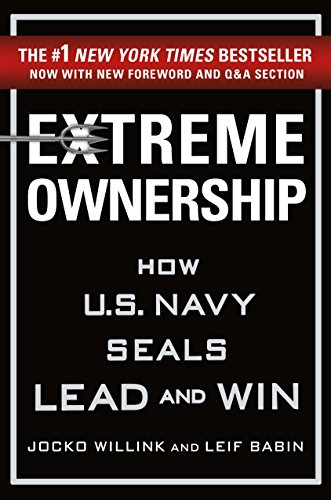Extreme Ownership Summary
4 min read ⌚
 How U.S. Navy SEALs Lead and Win
How U.S. Navy SEALs Lead and Win
You think that you have the team capable of winning, and now you only need some good leadership skills?
What you need is probably no more than few lessons from two U.S. Navy SEAL officers – Jocko Willink and Leif Babin – in “Extreme Ownership”!
Who Should Read “Extreme Ownership”? And Why?
This book is about breaking all imaginary boundaries that we have installed in our minds, and protect them with everything we got.
We find it suitable for all individuals who are tired of losing because the authors want to perk the audience up!!
About Jocko Willink and Leif Babin
 Jocko Willink
Jocko Willink and Leif Babin are decorated Navy SEAL officers, commandeer of the SEAL Team Three’s Task Unit bruisers during the bloody Battle of Ramadi.
and Leif Babin are decorated Navy SEAL officers, commandeer of the SEAL Team Three’s Task Unit bruisers during the bloody Battle of Ramadi.
After retiring from duty, they co-founded the consulting firm Echelon Front and authored the #1 New York Times bestseller, “Extreme Ownership.”
“Extreme Ownership PDF Summary”
We tend to think of leaders nowadays as intelligent and visionary white-collared men or successful corporate climbers.
However, we’ve already told you once or twice before that for most of the human history, there was only one type of leaders: military leaders.
Consequently, some authors leaf through the history books and figure out what it means to be a successful business leader by learning what it meant to be a great general.
Some other, however, don’t need books whatsoever – because they can tell you from experience.
Jocko Willink and Leif Babin are former Navy SEAL task unit, leaders.
In other words, it wasn’t the success of a company which depended on their leadership skills – but the lives of their men.
After retiring from duty, they realized that the same principles which helped them become great military leaders, may help company leaders do the same.
Because, after all, the business world is a modern battlefield.
Out there, on the real ones in Iraq, sometime in 2012, a soldier lost his life in a friendly fire. Jocko Willink was responsible for the unit. His action: to take full responsibility. The action of his superiors: to praise him.
Why?
Because, we are all humans, and, as such, we tend to make mistakes. The difference between good and bad leaders is a fairly simple one: the former admit them. No excuses.
Because leaders understand that they are part of something bigger than themselves. And that brings us to the next point: they believe in their mission. No matter what it may bring ahead.
Now, here’s a lesson straight from Navy SEAL books: “cover and move.”
It means one and one thing only: work as a team. Don’t think of your allies as competition.
Different departments of the same corporation usually transfer the blame to each other; if Navy SEALs do this – they’ll all probably die.
Why should it be any different in the case of company teams?
“Prioritize and execute” is yet another approach which is translatable from the military into corporate battlefields.
Namely, when under pressure, don’t lose your cool and be as well-organized as when everything’s okay. That’s the only way you’ll not jeopardize the success of your mission.
Of course, in order to do this, you need to also plan ahead. Identify the risks you can and analyze how you’d react in case the worst happens.
That way, you’ll be able to remain calm when it (almost inevitably) does.
Do the right thing at the right moment.
Key Lessons from “Extreme Ownership”
1. Cover & Move
2. Prioritize & Execute
3. Decentralize and Manage
Cover & Move
Navy SEAL tactic number 1: cover and move!
Or, in other words, work as a team! Leif Babin, one of the authors of this book, once exposed his team to serious danger because he was so focused on their problems that he forgot to see the big picture; namely, that there was another SEAL team in the vicinity which could have helped them.
So, find the team which could help you. And work as allies – not as competitors.
Prioritize & Execute
Navy SEAL tactic number 2: prioritize and execute!
SEALs remember this via a very simple mantra: “relax, look around, make a call.” Only three steps – but of vital importance to any operation. Because, there will be times when you’ll feel under pressure. Nevertheless, you’ll still have to act.
Don’t panic. Think carefully. And make the right call.
Decentralize and Manage
Finally, don’t ever forget that, as a general rule of thumb, no person can effectively manage more than a dozen people directly. Your company is probably much bigger.
So, do the math the Navy SEAL way! Divide your company into small teams (each no more than 6 members) and assign a leader to each of these teams.
Then, empower each of them and make them realize their duties and responsibilities.
And, of course, their superiors – for those rare cases when they’ll need them.
Like this summary? We’d like to invite you to download our free 12 min app, for more amazing summaries and audiobooks.
“Extreme Ownership” Quotes
It’s not what you preach, it’s what you tolerate. Share on X Our freedom to operate and maneuver had increased substantially through disciplined procedures. Discipline equals freedom. Share on X Admitting mistakes, taking ownership, and developing a plan to overcome challenges are integral to any successful team. Share on X Тhe most fundamental and important truths at the heart of Extreme Ownership: there are no bad teams, only bad leaders. Share on X Extreme Ownership. Leaders must own everything in their world. There is no one else to blame. Share on X
Our Critical Review
Wise people say – Take a deep breath to calm your nerves the minute you sense an urge to judge a person based on its momentary status or position.
You are not duty-bound to criticize or praise others, it’s best if you put in the spotlight your leadership skills!
It’s time to take action; don’t hesitate to instill a new mindset, and refrain yourself from comments.
Emir is the Head of Marketing at 12min. In his spare time, he loves to meditate and play soccer.


 How U.S. Navy SEALs Lead and Win
How U.S. Navy SEALs Lead and Win



